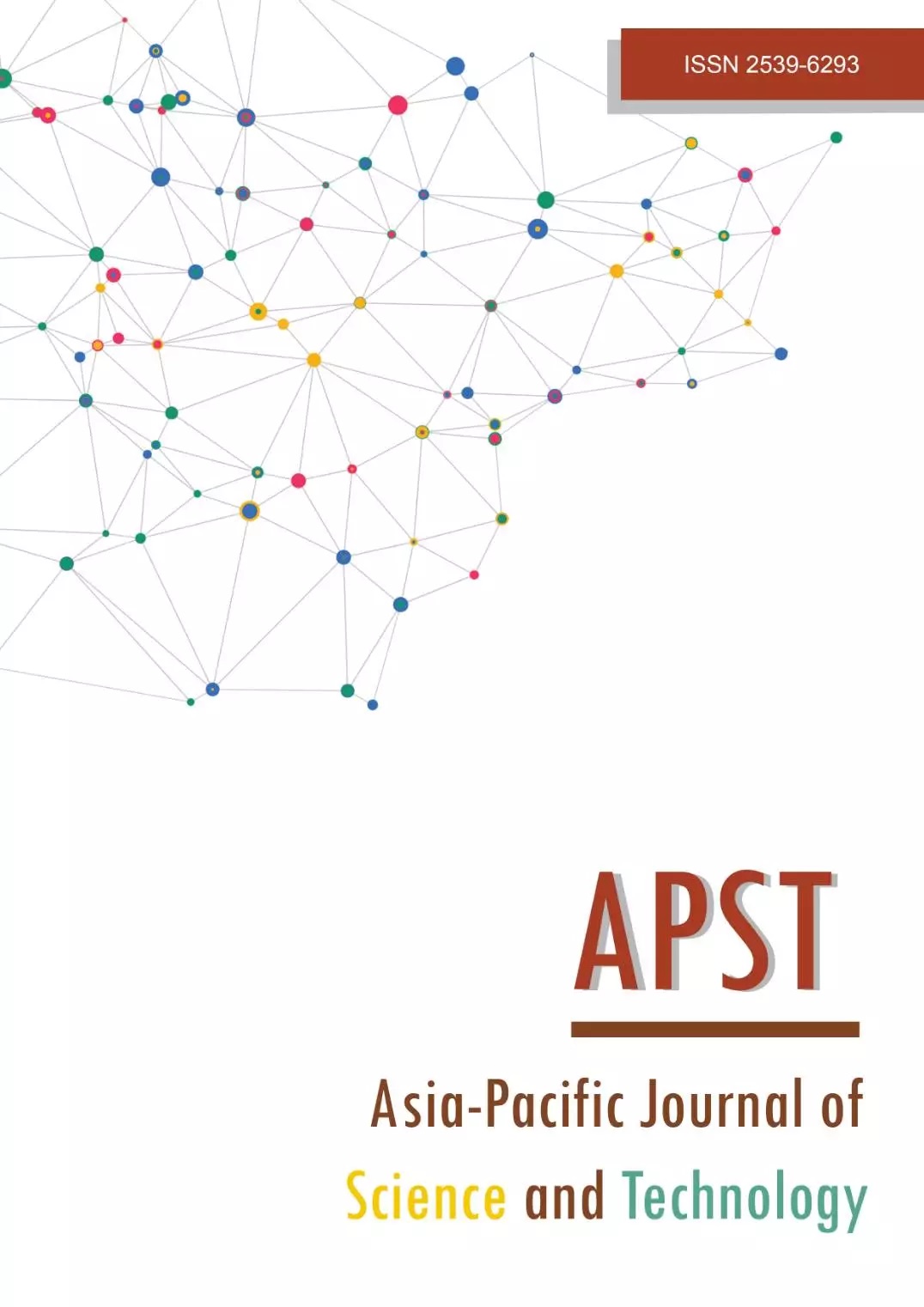Corrosion inhibition properties and pKa calculations of some common corrosion inhibitors: Quantum chemical simulations
Main Article Content
Abstract
Four organic compounds with various sizes, geometries, and reactive groups, namely hexylamine, morpholine, pyrazine carboxamide, and 11-mercaptoundecanoic acid, which have been reported experimentally for their corrosion inhibition property for both the bottom and the top metallic surfaces of the wet gas pipeline, are investigated by computational chemistry using density functional theory (DFT) simulations. Their inhibition properties are compared using several parameters such as HOMO/LUMO energies, global softness, and fraction of electrons transferred to metallic atoms. The reactive sites are studied through Fukui function. The fraction of protonated/deprotonated molecules to non-reactive molecules in water is determined by the acid dissociation constant, pKa, calculated over the thermodynamic cycle using Solvation Model Based on Density (SMD). Consideration of all these parameters suggests that pyrazine carboxamide may be the best potential candidate due to its highest reactivity and ability to donate electrons, with additional suitability for the top surface protection.
Article Details

This work is licensed under a Creative Commons Attribution-NonCommercial-NoDerivatives 4.0 International License.
References
Energy Institute. Oil and gas [Internet]. 2022 [cited 2022 Oct 4]; Available from: https://www.energyinst.org/exploring-energy/topic/oil-and-gas.
Belarbi Z, Vu TN, Farelas F, Young D, Singer M, Nešić S. Thiols as volatile corrosion inhibitors for top-of-the-line corrosion. Corrosion. 2017;73(7):892-899.
Zhang Z, Hinkson D, Singer M, Wang H, Nešić S. A mechanistic model of top-of-the-line corrosion. Corrosion. 2007;63(11):1051-1062.
Shen M, Furman A, Kharshan R, Whited T. Development of corrosion inhibitors for prevention of top of the line corrosion (TLC) [Internet]. Texas: NACE International; 2022 [cited 2022 Oct 4]. Available from: https://www.cortecvci.com/Publications/Papers/2013-NACE-2509.pdf.
Chauhan DS, Quraishi MA, Qurashi A. Recent trends in environmentally sustainable sweet corrosion inhibitors. J Mol Liq. 2021;326:115117.
Abbout S. Green inhibitors to reduce the corrosion damage. In: Singh A, editor. Corrosion. London: IntechOpen; 2020. p. 1-14.
Prenosil M. Volatile corrosion inhibitor coatings [Internet]. 2022 [cited 2022 Mar 22]. Available from: https://www.cortecvci.com/Publications/Papers/Nacereviewed/Pages14_17.pdf.
Belarbi Z, Farelas F, Singer M, Nešić S. Role of amines in the mitigation of CO2 top of the line corrosion. Corrosion. 2016;72(10):1300-1310.
Al-Moubaraki AH, Obot IB. Top of the line corrosion: causes, mechanisms, and mitigation using corrosion inhibitors. Arab J Chem. 2021;14(5):103116.
Gangopadhyay S, Mahanwar PA. Recent developments in the volatile corrosion inhibitor (VCI) coatings for metal: a review. J Coat Technol Res. 2018;15(4):789-807.
Abdallah M, Sobhi M, Altass HM. Corrosion inhibition of aluminum in hydrochloric acid by pyrazinamide derivatives. J Mol Liq. 2016;223:1143-1150.
Tan B, Lan W, Zhang S, Deng H, Qiang Y, Fu A, et al. Passiflora edulia sims leaves extract as renewable and degradable inhibitor for copper in sulfuric acid solution. Colloids Surf A: Physicochem Eng Asp. 2022;645:128892.
Guo L, Tan J, Kaya S, Leng S, Li Q, Zhang F. Multidimensional insights into the corrosion inhibition of 3,3-dithiodipropionic acid on Q235 Steel in H2SO4 medium: a combined experimental and in silico investigation. J Colloid Interface Sci. 2020;570:116-124.
Ammouchi N, Allal H, Belhocine Y, Bettaz S, Zouaoui E. DFT computations and molecular dynamics investigations on conformers of some pyrazinamide derivatives as corrosion inhibitors for aluminum. J Mol Liq. 2020;300:112309.
Neese F. The ORCA program system. WIREs Comput Mol Sci. 2012; 2(1):73-78.
Saha SK, Hens A, Murmu NC, Banerjee P. A comparative density functional theory and molecular dynamics simulation studies of the corrosion inhibitory action of two novel N-heterocyclic organic compounds along with a few others over steel surface. J Mol Liq. 2016;215:486-495.
Gázquez JL, Cedillo A, Vela A. Electrodonating and electroaccepting powers. J Phys Chem A. 2007; 111(10):1966-1970.
Lian P, Johnston RC, Parks JM, Smith JC. Quantum chemical calculation of pKas of environmentally relevant functional groups: carboxylic acids, amines, and thiols in aqueous solution. J Phy Chem A. 2018; 122(17):4366-4374.
Pliego JR. Thermodynamic cycles and the calculation of pKa. Chem Phys Lett. 2003;367(1-2):145-149.
Chemcraft. Graphical program for visualization of quantum chemistry computations [Internet]. 2021 [cited 2022 Oct 4]. Available from: http://www.chemcraftprog.com/.
Dean JA. Lange’s handbook of chemistry. London: Mcgraw-Hill; 1998.
Zhang Y, Mitchison D. The curious characteristics of pyrazinamide: a review. Int J Tuberc Lung Dis. 2003;7(1):6-21.
den Hertog AL, Menting S, Pfeltz R, Warns M, Siddiqi SH, Anthony RM. Pyrazinamide is active against mycobacterium tuberculosis cultures at neutral pH and low temperature. Antimicrob Agents Chemother. 2016;60(8):4956-4960.
Chen X, Chen Y, Cui J, Li Y, Liang Y, Cao G. Molecular dynamics simulation and DFT calculation of “green” scale and corrosion inhibitor. Comput Mater Sci. 2021;188:110229.
Allal H, Belhocine Y, Zouaoui E. Computational study of some thiophene derivatives as aluminium corrosion inhibitors. J Mol Liq. 2018;265:668-678.
Gómez B, Likhanova NV, Domínguez-Aguilar MA, Martínez-Palou R, Vela A, Gázquez JL. Quantum chemical study of the inhibitive properties of 2-pyridyl-azoles. J Phys Chem B. 2006;110(18):8928-8934.


